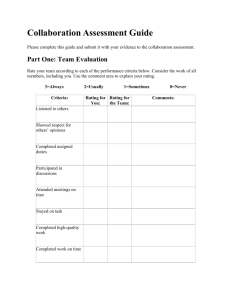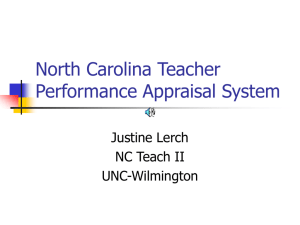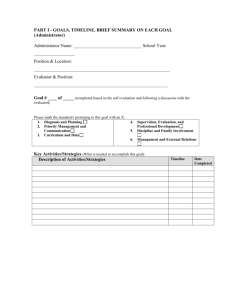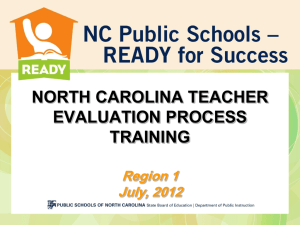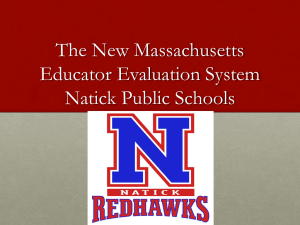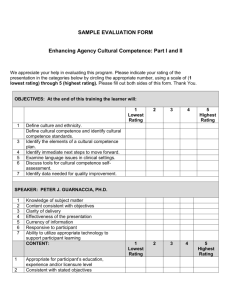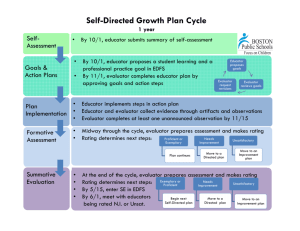North Carolina Teacher Performance Appraisal System
advertisement
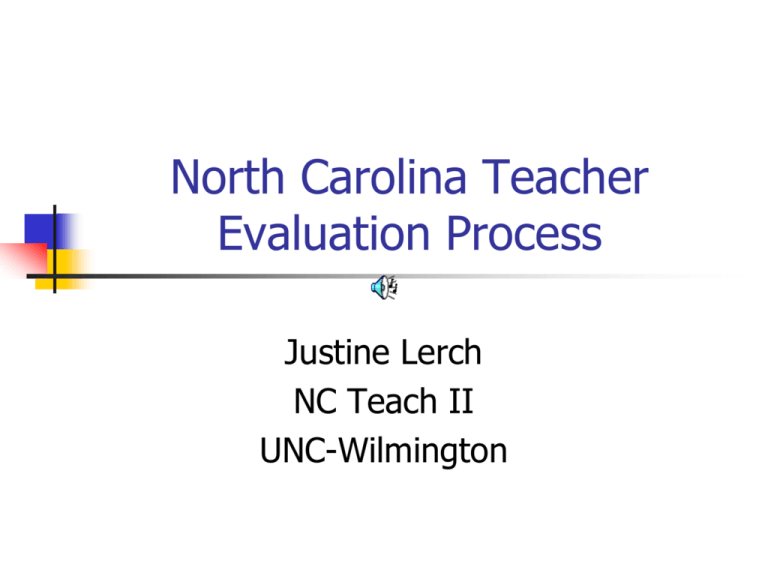
North Carolina Teacher Evaluation Process Justine Lerch NC Teach II UNC-Wilmington Agenda Welcome Back Lesson Presentation PPT of the evaluation process, required documents, and timelines Activities to reinforce learning Review Homework Assignment (20 pts.) Closure Objective To develop an understanding of the North Carolina Teacher Evaluation Process including: Instruments Process Forms Timelines Terms and Definitions NC Educator Evaluation System 2008 The purpose of the system is to promote and support effective leadership, quality teaching, and student learning. The instruments are based on the Framework for 21st Century Learning and the NC Standards. All of the instruments and processes are designed to encourage professional growth, to be flexible and fair to the persons being evaluated, and to serve as the foundation for professional development needs. Focus and Reflection Consider the best teacher you’ve ever known. What made that teacher so memorable? In what way has that teacher influenced your life? What are the specific characteristics and behaviors that describe that effective teacher? Consider a child starting kindergarten in 2010… This child was born in 2005 This child was not alive when 9/11 occurred The US has been at war for this child’s entire life We will need to educate this child for a life that will bring retirement in 2075 or later NORTH CAROLINA’S Educational Pipeline In North Carolina, for every 100 9th grade students… …70 students graduate four years later. …41 students enter college. …28 students are still enrolled in their 2nd year. …19 students graduate with either an Associate’s degree within three years or a Bachelor’s degree within six years. Source: www.achieve.org 7 Did You Know? Future Ready Students for the 21st Century The guiding mission of the NC Board of Education is that every public school student will graduate from high school, globally competitive for work and post secondary education and prepared for life in the 21st century. To accomplish this mission, North Carolina Public Schools will: Produce globally competitive students Be led by 21st century professionals Be healthy and responsible Leadership will guide innovation in NC Public schools Be governed and supported by 21st Century Systems 10 21st Century Skills Framework North Carolina Professional Educator Evaluation Systems Their purpose is to support and promote effective leadership, quality teaching, and student learning. The design is a growth model to improve instruction and enhance professional practice. The evaluation instruments are based on the Framework for 21st Century Learning and the Standards 12 North Carolina Professional Educator Evaluation Systems They are flexible enough to be fair to teachers and school executives of varying levels of experience and in school settings. The rubrics are formative in nature based on a rating scale from developing through distinguished. Multiple data sources, artifacts, and evidence will be used in assessing educator performance. They will provide the basis for performance goals and professional development activities. 13 Purposes for Evaluation Serve as a measure of performance Serve as a guide for reflection Serve as the basis for instructional improvement Focus the goals and objectives of schools and districts as they support, monitor, and evaluate teachers Guide professional development programs Purposes Continued Serve as a tool for developing coaching and mentoring programs Enhance the implementation of the approved curriculum Inform higher education institutions as they develop the content and requirements for teacher training programs. Artifact – A product resulting from a teacher’s work (a natural by-product, not a newly created document) Possible Artifacts: Professional Development School Improvement Plan Student Work School Improvement National Board Certification Team PTSA North Carolina Teacher Professional Learning Working Conditions Communities (PLC) Survey Lesson Plans Student Achievement Student Dropout Data Data 16 Definitions Beginning Teacher - Teachers who are in their first three years of teaching and who hold a Standard Professional 1 License Probationary Teacher – Teachers who have not obtained Career Status in their district Career Status Teachers –Teachers who have been granted Career Status in their district Formal Observation – an observation of a teacher’s performance for a minimum of 45 minutes or one complete lesson 17 Definitions Informal Observation – An observation of a teacher for a minimum of 20 minutes North Carolina Teacher Rubric – A composite matrix of the standards, elements and descriptors of the North Carolina Standards for Teachers Performance Standard – The distinct aspect of leadership or realm of activities which form the basis for the evaluation of a teacher Performance Elements – The sub-categories of performance embedded within the standard 18 Definitions Performance Descriptors – The specific performance responsibilities embedded within the components of each performance standard Performance Goals - Goals for improvement in professional practice based on the self-evaluation and/or supervisor recommendation 19 NC Professional Teaching Standards – Rating Scale Developing – Demonstrated adequate growth but did not demonstrate competence on standard(s) of performance Proficient – Demonstrated basic competence on standard(s) for performance Accomplished – Exceeded basic competence on standard(s) of performance most of the time Rating Scale Continued Distinguished – Consistently and significantly exceeded basic competence on standard(s) of performance Not Demonstrated – Did not demonstrate competence on, or adequate growth toward, achieving standard(s) of performance [NOTE: If the “Not Demonstrated” rating is used, the evaluator must comment about why it was used.] Teacher Responsibilities Know and understand the NC Professional Teaching Standards Understand the NC Evaluation Process Prepare for and fully participate in each component of the evaluation process Gather data, artifacts, evidence to support performance and progress in attaining goals Develop and implement strategies to improve performance in areas identified (IGP/PDP) A Vision of K-12 Students Today http://www.teachertube.com/view___video.php?viewke y=d1296214afd7cc367045 NC Standards for Teachers Standard 1: Teachers demonstrate leadership Standard 2: Teachers establish a respectful environment for a diverse population of students Standard 3: Teachers know the content they teach Standard 4: Teachers facilitate learning for their students Standard 5: Teachers reflect on their practice Great Quotes From Great Leaders If your actions inspire others to dream more, learn more, do more and become more, you are a leader. John Quincy Adams Standard I: Teachers Demonstrate Leadership Teachers lead in their classrooms Teachers demonstrate leadership in the school Teachers lead the teaching profession Teachers advocate for school and students Teachers demonstrate high ethical standards Making It Real Activity Standard I In what ways can a teacher model or demonstrate Teacher Leadership in the classroom, the school and the teaching profession? Table Activity: Choose a recorder and discuss the question above. List selected ideas on chart paper (at least 1-2 ideas for each of the three areas: classroom, school & teaching profession). Select a reporter to report out to the group. Standard II Teachers establish a respectful environment for a diverse population of students Teachers provide an environment in which each child has a positive, nurturing relationship with caring adults Teachers embrace diversity in the school community and in the world Teachers treat students as individuals Teachers adapt their teaching for the benefit of student with special needs Teachers work collaboratively with the families and significant adults in the lives of their students Making it Real Activity--Standard II What is a working definition of Diverse Learners? Discuss with your table group Write one definition per table Share with the whole group Making It Real--Standard II Think/Pair/Share Activity • • • Pair with a person and share: One strategy you have seen or done that models an environment that is inviting, respectful, supportive, inclusive & flexible When time is called, go to a second person and share: One strategy for maintaining high expectations for students When time is called, choose a third person and share: One strategy for collaboration with families/significant adults of students Standard III: Teachers know the content they teach Teachers align their instruction with the NC SCoS Teachers know the content appropriate to their teaching specialty Teachers recognize the interconnectedness of content areas/disciplines Teachers make instruction relevant to students Making It Real Activity--Standard III Sort the artifacts/behaviors (pink) into the appropriate performance elements (green) Then, decide where each artifact would rate on the performance scale (blue) When directed, circulate and compare your table ratings with one other table The mediocre teacher tells. The good teacher explains. The superior teacher demonstrates. The great teacher inspires. William Ward Standard IV: Teachers facilitate learning for their students Teachers know the ways that learning takes place, and they know the appropriate levels of intellectual, physical, social, and emotional development of their students Teachers plan instruction appropriate for their students Teachers use a variety of instructional methods Teachers integrate and utilize technology in their instruction Standard IV: Continued Teachers help students develop critical thinking and problem solving skills Teachers help students work in teams and develop leadership qualities Teachers communicate effectively Teachers use a variety of methods to assess what each student has learned Making It Real Activity—Standard IV Read the standard and the descriptors Write one or two observable behaviors or artifacts that could be used as evidence When the signal is given (2 min.), pass your paper clockwise Look over what has been recorded and add new behaviors/artifacts Continue… Standard IV Group Activity Count off into groups A - H Using the corresponding element (A - H) for your group, select 2 of the listed items under your element. (Page 9 or 10 in your manual) Brainstorm 2-3 specific behaviors a teacher might use to demonstrate each of the items selected Pick one of the two items and report out to the group 37 Standard V: Teachers reflect on their practice Teachers analyze student learning Teachers link professional growth to their professional goals Teachers function effectively in a complex dynamic environment Making It Real Activity Standard V Individually read the post observation dialogue As a group, decide a rating for each element of Standard V Determine an overall rating for Standard V List an additional question that a principal might ask about this standard. Making It Real Activity Card Sort In groups use the cards to match: The standard The elements for each standard The definitions for each element Teacher Evaluation Process Training Orientation Self Assessment Pre Observation Conference Observations Teacher Evaluation Process Post Observation Conference Summary Evaluation Conference and Scoring the Teacher Summary Rating Form Professional Development Plans Effective Dates, Licensing, Career Status The talent of success is nothing more than doing what you can do, well. Henry W. Longfellow The Evaluation Process Orientation: Within two weeks of a teacher’s first day Must include rubric, policy & schedule of evaluation The teacher self-assessment: Uses the teacher rubric Is done by individual (without input from others) Used in developing IGP Used in pre and post conference discussions Pre Observation Conference A pre-observation conference must occur before any observations happen during the year. Discuss: self-assessment, PDP & lesson(s) to be observed Teacher will have written description of lesson for first observation Subsequent observations do not require a pre-observation conference Observations Formal observations occur over one complete lesson (a minimum of 45 minutes) Probationary teachers require 4 formal observations: 3 administrative, 1 peer Career status teachers (in their summative year of evaluation) must have three observations: at least 1 must be formal The first observation must be a formal, announced observation Subsequent observations may be unannounced Evaluator uses the rubric as a recording tool Post Conferences Must occur after each observation Must occur no later than 10 school days after the observation Designed for the purpose of identifying areas of strength and those in need of improvement Requires review and signature of rubric Summary Evaluation Conference Bring Self Assessment Review Observations Discuss Additional Artifacts Sign Summary Rating Form & Record of Teacher Evaluation Activities Begin discussion for future goals Summary Rating Form Every element for every standard is marked (“not demonstrated” requires comment) Ratings are based on formal and informal observations throughout the year Overall rating for each standard is chosen by the evaluator after reviewing all of the elements within a standard. Comments can be added from evaluator or the teacher. Signatures required on the final page. Record of Teacher Evaluation Form Required to be completed at the conclusion of the Summary Conference Used as documentation that process was completed Must be signed & dated for each activity Professional Development Plan Teachers who are rated as “Proficient” or higher on all Standards will develop an Individual Growth Plan Teachers who are rated as “Developing” on any Standard will be placed on a Monitored Growth Plan Teachers who are rated as “Not Demonstrated” on any Standard or has a rating of “Developing” for two sequential years will be placed on a Directed Growth Plan (meets GS requirements of an action plan) Cannot be used w/ any teacher being recommended for dismissal, demotion or nonrenewal Language Analysis Evidence Observable and specific Not influenced by the observer Objective unambiguous Opinion Draws conclusions Influenced by the observer’s perspective Subjective May be subject to debate Areas Of Concern For New Teachers In The Evaluation Process Classroom management -discipline Time management Motivating students Dealing with individual differences Dealing with problems of individual students Areas of Concern - Continued Assessing students’ work Relations with parents Insufficient materials and supplies Organization of class work Additional Information All observations and summative evaluations should be conducted by individuals who have had extensive training in the use of the observation/evaluation instruments Multiple practice observations are scheduled to verify observer/evaluator accountability Notes Continued Observations should last the class period or until the end of the instructional activity. If a significant interruption occurs, the observation may be stopped, the reason for discontinuing noted, and the observation completed at a later time. Notes Continued Observer should not expect to observe all teaching practices during any particular observation. The evaluator should meet with the teacher to review what was not observed and collect additional information from lesson plans, student work and communication with parents. Notes Continued Best practices encourage multiple sources of data. The teacher and/or the observer may place written comments regarding the evaluation on the TPAI. Only the Superintendent can recommend that a teacher be dismissed. Criteria for Teacher Evaluation Knowledge of Delivery Methods Understanding the Learning Process Knowledge of Content Area Understanding of Student Needs Ability to Demonstrate Evidence of Student Growth Curriculum Alignment Criteria for Teacher Evaluation - Continued Understanding and Use of Standard Course of Study in Instruction and Assessment Ability to Disaggregate & Use Student Achievement Data in Planning Instruction Classroom Management Criteria for Teacher Evaluation - Continued Professional Growth/Continuous Improvement Ability to use Technology as a Tool in the Classroom Communication with Stakeholders Inside and Outside the School Setting Teaching is Amazing! Homework Self Assessment Worth 20 points Due Saturday, September 11, 2010 via Task Stream Using the Rubric for Evaluating NC Teachers (in your notebook) complete a self assessment. Rate each element, list sample artifacts, sources, and or documented evidences that you will have to support your performance in each function. Be objective, concise, and specific. Homework –Part II Professional Development Plan Then, using the Professional Development Plan, page 1 (available on line), write two Goals for the year, listing activities/actions, expected outcomes and evidence of completion, resources needed, and an approximate date for completion. Closure Questions and Answers Comments Evaluation
